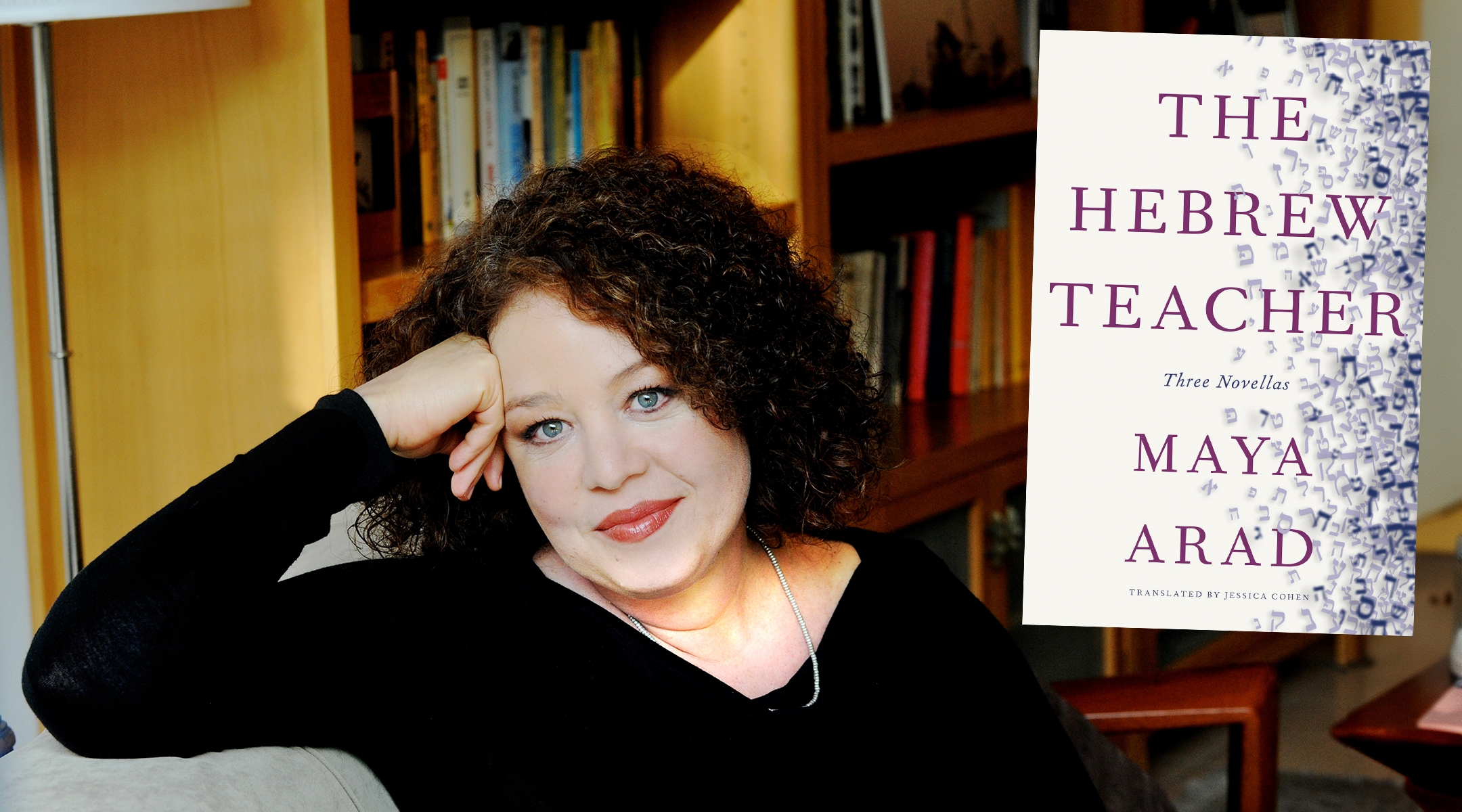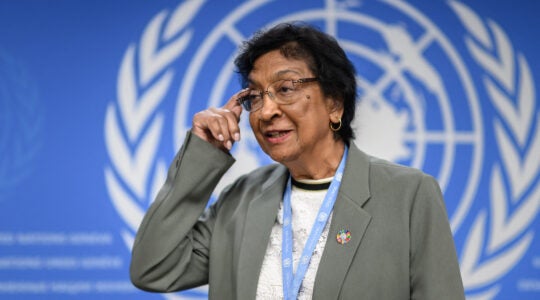(JTA) — In “Make New Friends,” a mother worries that her tween-age daughter has no friends, and that the pressures of social media will only make the girl’s isolation more acute.
In “A Visit (Scenes),” a mother flies to America to visit her distant son and self-involved daughter-in-law, desperate to connect with a grandchild she has seldom seen.
Such stories, two of three novellas in Maya Arad’s collection “The Hebrew Teacher,” are the stuff of suburban nightmares, universal in their ability to make anyone who has ever been a parent or a child break out in a cold sweat of empathy and dread.
But both stories are also particular: The characters are Israelis living in the United States, negotiating between English and Hebrew, their Jewishness and their Israeliness, old worlds and the new.
It’s a milieu that Arad, 53, knows well: A bestselling author in Israel, where 11 of her books have appeared in Hebrew, she has lived for 20 years in California, where she is a writer in residence at Stanford University’s Taube Center for Jewish Studies.
“The Hebrew Teacher” is her first book translated into English, and it introduces American readers to a writer that one Israeli reviewer has called “the finest living author writing in Hebrew.” Another critic calls her “an artist of suppressed despair, small humiliations and structural restraint.”
That restraint is evident in “A Visit (Scenes)” and “Make New Friends,” where the characters’ Israeli identities are both evident yet unremarkable — she leaves it to the reader to decide how much the characters’ Israeliness matters. But she foregrounds that question in the title novella, about a woman who has been teaching Hebrew at a midwestern college for decades. Her world is upended when the department hires a young Israeli scholar who is deeply critical of Israel and refuses to take part in the casually Zionist activities she has planned.
“Ima, you see the old folks at your synagogue,” her son responds when she complains about the “chutzpah” of the new instructor. “Young Jews in America are sick of your generation, which defends Israel at any cost no matter what it does.”
It’s a story of the moment, when among the many divides in the United States caused by the war in Gaza is a yawning chasm between a baffled Zionist old guard and young anti-Zionist activists.
Arad and I will be speaking in an online event on March 19, part of the Folio series the New York Jewish Week cosponsors with UJA-Federation of New York.
Ahead of our talk, I put a few questions to Arad via email.
The first novella in the collection is about Ilana, an Israeli Hebrew teacher at an American university who seems stunned by a new young colleague who is not only critical of Israel but appears not to be a Zionist. It’s a generational clash that seems very relevant and very prescient. Can you tell me what might have inspired the story?
Usually what inspires me to write is some plot twist, or a conflict. But in the case of “The Hebrew Teacher,” uncharacteristically, I started with a character — an older Hebrew teacher living in the U.S. I started writing this novella in 2015, a few months after it was decided that Hebrew writers who do not live in Israel are not eligible for any of the major literary prizes there. At that point I felt that I could relate to Ilana: Although we are very different, we are both Israeli women living in the US, making a living off Hebrew and realizing that the distance from our home country keeps growing over the years.
Is this an “American” story or are Israeli generations similarly divided by their Jewish and Israeli identities?
It’s very interesting, and I think in this respect this is indeed an “American” story. In Israel, political views are less defined by what generation one belongs to; it’s more about one’s background and milieu. Paradoxically, if Ilana had stayed back in Israel, she would have become aware of the new generation of post-Zionist scholars and historians. Having lived in the Midwest for 45 years, she keeps alive the nostalgic remains of a past Israel, still listening to Ilanit [a singer last popular in the 1980s], thinking of Etgar Keret as a “new” writer. But of course, Ilana half-realizes that times have changed. She knows it is “not a good time for Hebrew,” as she writes in the novella’s first page.
“A Visit (Scenes)” and “Make New Friends” are painful examinations of frayed family connections — and of one Israeli generation’s estrangement from another. Are these stories in any way a critique of America — or at least how America erodes family traditions and connections that might be stronger “back home”?
I don’t think I am a critic of American society. I love living here. And if you look at my books that are set in Israel, there’s a lot of dysfunction there, too. Partly it’s just about what literature is like. A friend asked me once about the three characters of the novella “A Visit”: Why are they like that? I told her, if they weren’t like that, I wouldn’t have a story. What’s the point of writing about a grandmother visiting her happily married son and daughter-in-law, who are thrilled to host her for three weeks?
What’s true is that dysfunction is different in different places, and there are styles of dysfunction. American Jews, I noticed, often have an ideal view of Israel as a country where everyone is close and family ties are very strong. While this is generally true, it can sometimes feel like one unending Thanksgiving dinner, which obviously has its own downside. Not to mention that those who are not close with their families, like Miriam, the grandmother from “A Visit,” carry some shame in addition to their pain — and this shame may be more common in Israel than in America.
This is your first book to be translated into English. Can you tell me a little bit about the journey — how you found a publisher and translator?
Books have their fate. For some reason I had weirdly good luck with the publication of my books in Hebrew — I met the right publishers, at the right time, and Hebrew readers were willing to read what I wrote. In English it was different. Maybe because my books often deal with Israeli expats, rather than with what one expects Hebrew literature to be about (Holocaust, the Mossad, the IDF, etc.). The upside is that now, when I’m translated, I have a body of work — I’m about to publish my 12th book in Israel — so this gives my American publisher more to work with.
I feel truly lucky to be working with Michael Wise from New Vessel Press and with my translator, Jessica Cohen. Jessica and I have been friends for a long time, and I have always greatly admired her work and hoped we’d get a chance to work together, and now it finally happened. She created such compelling, vivid English prose. I feel my characters come alive for the second time, and have actually gained, rather than lost something in the translation process.
How might audiences here respond differently than your Hebrew readers?
One can never tell how one’s work is received — I am very curious to see how American audiences might react to it. We’ll see.
So much has changed, in Israel and here, since Oct. 7. First I wanted to ask what we are all asking these days — how are you holding up?
I grew up in Kibbutz Nahal Oz. My house was less than a mile from Gaza. I know people who died or were kidnapped on Oct. 7 (but then, many Israelis do — it’s a small country). Growing up in Nahal Oz also means that I knew people from Gaza, and it breaks my heart that things have become what they are. People often say, “You wouldn’t think of this in your worst nightmares,” but this is beyond what we feared in our worst nightmares.
How has the war made you think about the role of literature in understanding Israel, and perhaps, your role as an Israeli writer and what audiences and perhaps colleagues might expect from you for good and ill?
I don’t want to exaggerate my role as a writer. A friend of mine, who is a writer and a psychologist, volunteered with trauma victims. This is a real contribution. Here, in the American context, I can make my small contribution in other ways. Perhaps the most important right now is that I give names and faces to Israeli characters. It is an especially ugly side of our times that, on the far left, some seek to deny the very existence of an Israeli identity. To the extent that I am successful as a writer (and thanks to Jessica’s translation), my characters are flawed, but real. So I hope I convey the obvious fact of the humanity of Israeli people.
JTA has documented Jewish history in real-time for over a century. Keep our journalism strong by joining us in supporting independent, award-winning reporting.






